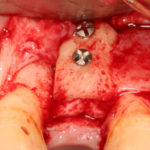
Resorption of bone following tooth loss is a normal physiological process. However, for implant placement minimal bone height and width is required. A range of techniques have been developed to augment deficient alveolar ridges. The approaches involve a range of materials including autogenous bone or bone substitutes.
The aim of this review was to compare the clinical outcomes of bone augmentation using autogenous bone and biomaterial in the posterior mandibular atrophic region prior to implant installation.
Methods
Searches were conducted in the PubMed/Medline, Scopus and Cochrane databases supplemented by searches of the journals: Clinical Implant Dentistry and Related Research, Clinical Oral Implant Research, Implant Dentistry, International Journal of Oral and Maxillofacial Surgery, Journal of Clinical Periodontology, Journal of Dental Research, Journal of Dentistry, Journal of Maxillofacial and Oral Surgery, Journal of Oral Implantology, Journal of Periodontology, and International Journal of Oral and Maxillofacial Implants. Randomised controlled trials (RCTs) or prospective clinical trials with at least 10 patients, and studies that compared patients who received grafts with bone substitutes with those who received autogenous bone grafts and published in English were considered.
Initial searches were conducted independently by 2 reviewers with one reviewer extracting data for checking by a second reviewer. Risk of bias was assessed independently by 2 reviewers using the Cochrane risk of bias tool. Continuous outcomes were compared using mean difference (MD) and dichotomous outcomes using risk ratios (RR).
Results
- 4 split-mouth studies (3 RCTs, 1 prospective study) involving a total of 44 patients were included.
- Average age of the patients was 53.66yrs.
- There was no significant different between biomaterials and autogenous bone grafts in terms of bone gain; MD = 0.59(95%CI; -0.13 to 1.31).
- No significant different was seen in respect of implants placed in biomaterials and autogenous bone grafts; RR = 1.57 (95%CI: 0.43 to 5.81)
Conclusions
The authors concluded: –
The current meta-analysis indicates that biomaterials or autogenous bone are indicated for the reconstruction of the posterior mandibular atrophic region, without lowering implant survival.
Comments
The reviewers have searched 3 databases and a number of journals although restricting the included studies to those published in English may have excluded relevant papers. All the included studies have used a split-mouth design however they are still small with the largest studies only involving 12 patients. While the authors have used the Cochrane risk of bias tool to assess bias they have only presented a summary figure which makes interpreting their assessment more difficult. As one of the studies is not randomised this will be at high risk of bias and masking of the operatives was unclear in two of the studies. The average follow up period of the included studies just over a year. So, while the findings suggest that there is no difference between the two techniques the results should be interpreted cautiously as both the quality and the availability of the evidence is limited.
Links
Primary Paper
de Sousa CA, Lemos CAA, Santiago-Júnior JF, Faverani LP, Pellizzer EP. Bone augmentation using autogenous bone versus biomaterial in the posterior region of atrophic mandibles: A systematic review and meta-analysis. J Dent. 2018 Sep;76:1-8. doi:10.1016/j.jdent.2018.06.014. Epub 2018 Jun 27. Review.PubMedPMID: 29959062.
Original review protocol on PROSPERO
Other references
Dental Elf – 12th Jul 2017
Dental Elf – 2nd Jun 2015
Alveolar ridge preservation: limited evidence for current techniques
Picture Credits
By Dental Specialty Group – Own work, CC BY-SA 3.0,
